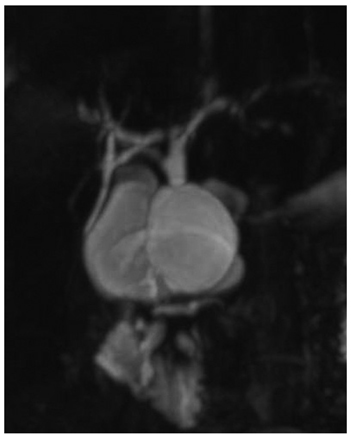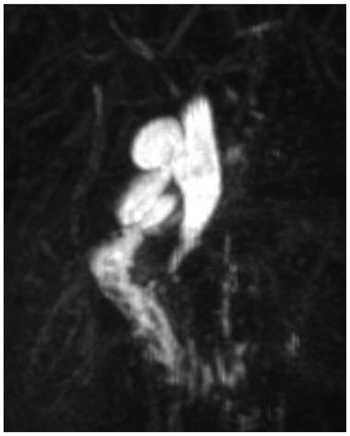Korean J Radiol.
2012 Feb;13(Suppl 1):S112-S116. 10.3348/kjr.2012.13.S1.S112.
Is Preoperative Subclassification of Type I Choledochal Cyst Necessary?
- Affiliations
-
- 1Department of Surgery, Seoul National University College of Medicine, Seoul National University Bundang Hospital, Seongnam 463-707, Korea. hanhs@snubh.org
- KMID: 1372876
- DOI: http://doi.org/10.3348/kjr.2012.13.S1.S112
Abstract
OBJECTIVE
The aim of this study was to evaluate the frequency of postoperative biliary stricture and its risk factors in patients undergoing surgery for type I choledochal cyst.
MATERIALS AND METHODS
A total of 35 patients with type I choledochal cyst underwent laparoscopic cyst excision and Roux-en-Y hepaticojejunostomy between August 2004 and August 2011. Their medical records and radiologic images (including endoscopic retrograde cholangiopancreatography, magnetic resonance cholangiopancreatography, pancreatobiliary computed tomography, or ultrasound) were retrospectively analyzed to evaluate the frequency of postoperative biliary stricture and its risk factors.
RESULTS
Postoperative biliary stricture was found in 10 (28.6%) of 35 patients. It developed more frequently in patients with type Ia choledochal cyst (53.8%, 7 of 13 patients) than in patients with type Ic choledochal cyst (13.6%, 3 of 22 patients), which was statistically significant (p = 0.011). There were no significant associations between other factors and postoperative biliary stricture.
CONCLUSION
Type Ia is a risk factor of postoperative anastomotic stricture. Therefore, preoperative radiologic subclassification of type Ia and Ic may be useful in predicting postoperative outcomes of choledochal cysts.
MeSH Terms
-
Adolescent
Adult
Anastomosis, Roux-en-Y
Biliary Tract Surgical Procedures/methods
Chi-Square Distribution
Child
Child, Preschool
Cholangiopancreatography, Endoscopic Retrograde
Cholangiopancreatography, Magnetic Resonance
Choledochal Cyst/*pathology/*surgery
Female
Humans
Infant
Jejunostomy/methods
Laparoscopy/*methods
Male
Middle Aged
Postoperative Complications/*diagnosis
Statistics, Nonparametric
Tomography, X-Ray Computed
Treatment Outcome
Ultrasonography/methods
Figure
Cited by 1 articles
-
Clinical characteristics of patients with malignancy and long-term outcomes of surgical treatment of patients with choledochal cyst
Wung Sun Han, Hongbeom Kim, Hee Ju Sohn, Mirang Lee, Yoon Hyung Kang, Hyeong Seok Kim, Youngmin Han, Jae-Seung Kang, Wooil Kwon, Jin-Young Jang
Ann Surg Treat Res. 2021;101(6):332-339. doi: 10.4174/astr.2021.101.6.332.
Reference
-
1. Todani T. Congenital choledochal dilatation: classification, clinical features, and long-term results. J Hepatobiliary Pancreat Surg. 1997. 4:276–282.2. O'Neill JA Jr, Templeton JM Jr, Schnaufer L, Bishop HC, Ziegler MM, Ross AJ 3rd. Recent experience with choledochal cyst. Ann Surg. 1987. 205:533–540.3. Todani T, Watanabe Y, Toki A, Morotomi Y. Classification of congenital biliary cystic disease: special reference to type Ic and IVA cysts with primary ductal stricture. J Hepatobiliary Pancreat Surg. 2003. 10:340–344.4. Matsumoto Y, Fujii H, Yoshioka M, Sekikawa T, Wada T, Yamamoto M, et al. Biliary strictures as a cause of primary intrahepatic bile duct stones. World J Surg. 1986. 10:867–875.5. Todani T, Watanabe Y, Urushihara N, Noda T, Morotomi Y. Biliary complications after excisional procedure for choledochal cyst. J Pediatr Surg. 1995. 30:478–481.6. Al-Mofleh IA, Aljebreen AM, Al-Amri SM, Al-Rashed RS, Al-Faleh FZ, Al-Freihi HM, et al. Biochemical and radiological predictors of malignant biliary strictures. World J Gastroenterol. 2004. 10:1504–1507.7. Faust TW, Reddy KR. Postoperative jaundice. Clin Liver Dis. 2004. 8:151–166.8. Tuvignon N, Liguory C, Ponchon T, Meduri B, Fritsch J, Sahel J, et al. Long-term follow-up after biliary stent placement for postcholecystectomy bile duct strictures: a multicenter study. Endoscopy. 2011. 43:208–216.9. Kim JH, Choi TY, Han JH, Yoo BM, Kim JH, Hong J, et al. Risk factors of postoperative anastomotic stricture after excision of choledochal cysts with hepaticojejunostomy. J Gastrointest Surg. 2008. 12:822–828.10. Cho MJ, Hwang S, Lee YJ, Kim KH, Ahn CS, Moon DB, et al. Surgical experience of 204 cases of adult choledochal cyst disease over 14 years. World J Surg. 2011. 35:1094–1102.11. Kim JW, Moon SH, Park do H, Lee SS, Seo DW, Kim MH, et al. Course of choledochal cysts according to the type of treatment. Scand J Gastroenterol. 2010. 45:739–745.12. Lenriot JP, Gigot JF, Ségol P, Fagniez PL, Fingerhut A, Adloff M. Bile duct cysts in adults: a multi-institutional retrospective study. French Associations for Surgical Research. Ann Surg. 1998. 228:159–166.13. Todani T, Watanabe Y, Narusue M, Tabuchi K, Okajima K. Congenital bile duct cysts: classification, operative procedures, and review of thirty-seven cases including cancer arising from choledochal cyst. Am J Surg. 1977. 134:263–269.14. Tan SS, Tan NC, Ibrahim S, Tay KH. Management of adult choledochal cyst. Singapore Med J. 2007. 48:524–527.15. Miyano T, Yamataka A, Kato Y, Segawa O, Lane G, Takamizawa S, et al. Hepaticoenterostomy after excision of choledochal cyst in children: a 30-year experience with 180 cases. J Pediatr Surg. 1996. 31:1417–1421.16. Todani T, Watanabe Y, Toki A, Ogura K, Wang ZQ. Co-existing biliary anomalies and anatomical variants in choledochal cyst. Br J Surg. 1998. 85:760–763.17. Stringer MD. Wide hilar hepaticojejunostomy: the optimum method of reconstruction after choledochal cyst excision. Pediatr Surg Int. 2007. 23:529–532.18. Urushihara N, Fukuzawa H, Fukumoto K, Sugiyama A, Nagae H, Watanabe K, et al. Totally laparoscopic management of choledochal cyst: Roux-en-Y Jejunojejunostomy and wide hepaticojejunostomy with hilar ductoplasty. J Laparoendosc Adv Surg Tech A. 2011. 21:361–366.19. Abbas HM, Yassin NA, Ammori BJ. Laparoscopic resection of type I choledochal cyst in an adult and Roux-en-Y hepaticojejunostomy: a case report and literature review. Surg Laparosc Endosc Percutan Tech. 2006. 16:439–444.20. Tang ST, Yang Y, Wang Y, Mao YZ, Li SW, Tong QS, et al. Laparoscopic choledochal cyst excision, hepaticojejunostomy, and extracorporeal Roux-en-Y anastomosis: a technical skill and intermediate-term report in 62 cases. Surg Endosc. 2011. 25:416–422.21. Nguyen Thanh L, Hien PD, Dung le A, Son TN. Laparoscopic repair for choledochal cyst: lessons learned from 190 cases. J Pediatr Surg. 2010. 45:540–544.



